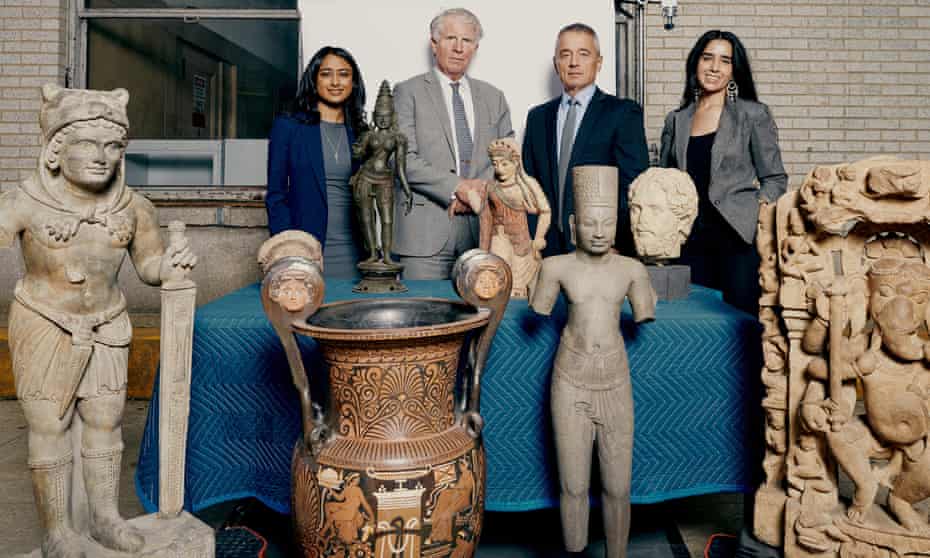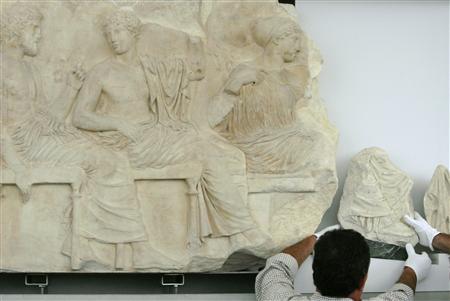Restituzione di Beni Culturali italiani- Cultural Heritage Restitution
US begins returning $10m of antiquities stolen from Italy
Source: The Guardian
Investigation recovers 200 artefacts including statue unwittingly bought by reality TV star Kim Kardashian West


The Manhattan district attorney, Cyrus Vance, centre left, with members of the antiquities trafficking unit and eight of the artefacts. Photograph: Vincent Tullo/New York Times/Redux/eyevine
The US is returning 200 antiquities, including an ancient Roman sculpture that almost ended up in the possession of Kim Kardashian West, that were stolen and smuggled out of Italy.
The variety of Roman, Etruscan and Greek artefacts, valued at $10m (£7.5m), had been looted since at least the early 1980s before being smuggled out and sold to private collectors, museums or auction houses. Half were found at New York’s Fordham Museum of Greek, Etruscan, and Roman Art as part of an investigation led by the Manhattan district attorney, Cyrus Vance.
A white marble head of the Roman emperor Settimio Severo that had been stolen in 1984 from a museum in Italy’s southern Campania region was found in June 2020 just as it was about to be put up for auction at Christie’s in New York.
Other artefacts include a 7th century BC ceramic vessel called Pithos with Ulysses, and a 4th century BC terracotta image of a goddess known as A Head of Maiden.
Kardashian unwittingly became caught up in the investigation this year after the US government named her in a civil forfeiture claim for an ancient Roman statue, originally looted from Italy, that was confiscated at Los Angeles port in 2016. The statue, known as the Fragment of Myron’s Samian Athena, was bought by the reality TV star from a Belgian art dealer and was part of a shipment in her name that contained 40 antiques. She was not accused of any wrongdoing.
The vast majority of the stolen artefacts are believed to be connected to Edoardo Almagià, an Italian antiques dealer who lived in New York until 2003. Almagià was investigated in Italy for smuggling and selling stolen artefacts, but he will not face criminal charges since the statute of limitations for the crime has expired.
“He is free and living in Rome,” said General Roberto Riccardi, the chief of Italy’s cultural heritage protection squad. “Lots of time has passed and so the crime is no longer pursuable.”
Almagià was investigated for decades by Italy and the US, with Italian authorities alleging his business contributed to “one of the biggest lootings of Italian cultural heritage”. According to the news channel TGCom24, he has defended himself, saying: “There are thousands if art objects travelling the world without documents and in the past it was always like this,” adding that “only now have the Italian and American regulations become stricter”. Almagià said the money spent on the investigation could have been spent “repairing Italian museums rather than on persecuting traders”.
One hundred and sixty of the artefacts will travel back to Rome on Thursday with Riccardi, while 40 others will go on display in an exhibition at the Italian consulate in New York until March.
Italy’s cultural heritage protection squad was established in 1969 and has since retrieved more than 3m stolen artefacts. The team recently recovered more than 2,000 relics looted from Taranto, in Puglia, which ended up in Germany, Belgium, the Netherlands and Switzerland.
“The thefts create incalculable damage to our heritage and culture,” said Riccardi. “Firstly, a community loses an object of its heritage. Secondly, a whole mine of information for archaeologists disappears when an artefact is removed from its context.”

